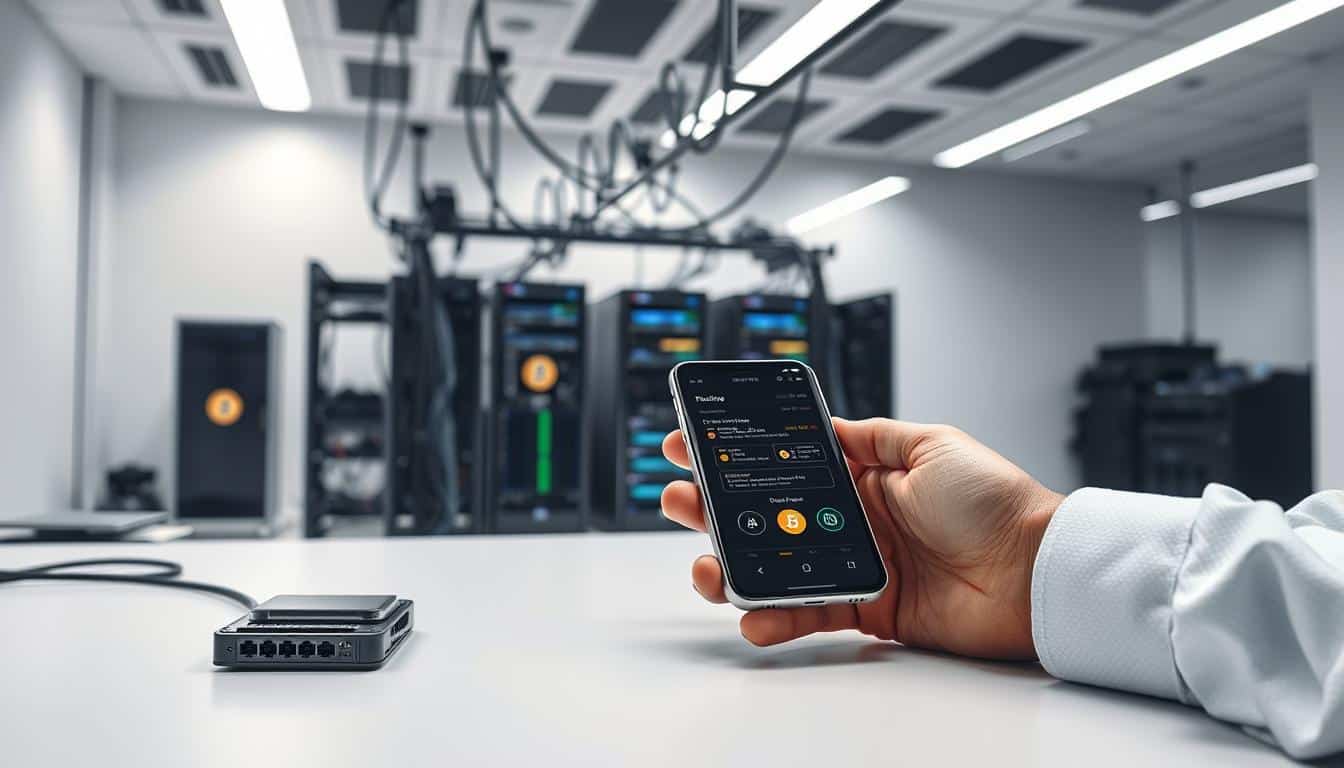Almost half of the crypto losses at institutions come from a single weak point. This alarming fact pushed me to change my fund protection methods. After dodging a phishing attack by a hair, we switched to a multi-signature system within a week. My personal journey will guide you through this multi-signature wallet setup.
I’m here to guide you on why multi-sig is crucial and how to securely set one up. I will also discuss what platforms to consider and the realities of making such a choice. This information is especially for those who like doing things themselves but want to stay safe.
Understanding the regulatory landscape is crucial. For instance, the Bank of England’s head, Andrew Bailey, insists on advanced data science and tech for market security, as reported by PANews on Sept 23. Moreover, adopting multi-sig practices aligns with regulatory goals to fill current security gaps.
The story of a church in Mokpo, South Korea, losing $348,000 in a crypto scam is heartbreaking. This incident underscores why pooled or institutional funds should be protected by shared custody.
Centralized exchanges still have their place, requiring KYC and holding assets for users. However, for those wanting more control, opting for a self-custodial multi-signature wallet is the best choice. Later, I’ll share a visual comparison and statistics to support my suggestions.
Learning to use multi-sig might seem daunting, but it’s definitely worth the effort. This article offers a practical guide for setting up a multi-signature wallet the right way. You’ll find hands-on instructions, platform reviews, and a checklist of best practices for a foolproof setup.
Key Takeaways
- Multi-signature wallets reduce single points of failure and are ideal for pooled or institutional funds.
- I moved to multi-sig after a phishing near-miss — practical experience informs these steps.
- Regulators like Andrew Bailey urge better tech and data use; custody improvements align with that trend.
- Real losses, such as the Mokpo church scam, show why shared custody matters.
- This guide will cover how to set up multi-sig crypto wallet, platform choices, and practical tradeoffs.
What is a Multi-Signature Crypto Wallet?
I moved from using a hardware wallet with just one signature to a 2-of-3 multi-sig system. I quickly saw it meant more steps for a lot more trust. In simple words, a multi-signature wallet needs more than one key to say yes to any spending. This is seen in setups like 2-of-3 or 3-of-5, where funds only move after enough keys agree.
Definition and Key Features
Multi-sig wallets are all about sharing the power to give the ok. Instead of one key signing off on everything, a multi-sig splits the task among several people. For Bitcoin, this is usually done with multisig scripts. For Ethereum and similar chains, smart contracts manage the rules.
Some cool features of multi-sig wallets are being able to set how many approvals you need, different models of agreement, working with popular hardware wallets, breaking up the seed phrase, adding time locks, and ways to get back in if things go wrong. You can have a mix of signers like hardware devices, software wallets, or even a service that handles it for you. Third-party services keep an eye on legal stuff and know your customer (KYC) rules. But signers who keep their own keys are independent.
How It Differs from Traditional Wallets
Single-signature wallets use one key, keeping it basic but risky. Lose this key, and you might lose your money. If someone else gets it, they could take everything.
Multi-sig spreads out this risk. No one person can decide to move money on their own unless the setup allows. This makes it safer for groups, DAOs, and people managing a lot of money. It offers a middle ground between total self-control and letting an exchange hold your keys. Exchanges check your ID and have control over your keys. Multi-sig keeps you in charge but brings in rules for group decisions.
At first, needing more gadgets and more people saying yes seemed like a hassle to me. But after doing it a few times, I felt a lot better knowing it was safer. The fallout from the Mokpo church shows the dangers of one person having all the power. Stories in PANews tell us that fancy technology or data alone can’t always protect assets. Requiring multiple people to agree for a multi-sig could stop one person from misusing funds.
| Aspect | Single-Sig Wallet | Multi-Sig Wallet |
|---|---|---|
| Authorization Model | One private key signs | M-of-N threshold signing |
| Risk Profile | Single point of failure | Distributed risk, resilient |
| Implementation | Private key + seed phrase | On-chain script (Bitcoin) or smart-contract (Ethereum) |
| Signer Types | Hardware or software key | Hardware, software, custodial, mixed |
| Recovery Options | Seed phrase restore | Seed fragmentation, timelocks, social recovery patterns |
| Best Use | Individual users wanting simplicity | Teams, treasuries, high-value holdings |
Importance of Security in Cryptocurrency
Time and again, a new protocol launches, followed by news of losses. Ensuring the safety of digital currencies affects everyday people, including churches, charities, and local government funds. Good security practices in cryptocurrency significantly reduce risks and increase trust for all involved.
Recent data on crypto theft highlight the serious risks. Reports from the industry reveal that hacks, scams, and rug pulls lead to billions lost each year. Firms like Chainalysis have estimated losses in the billions, pointing out that over $2 billion was lost in 2025 due to attacks on crypto services alone. Major incidents have included breaches of exchanges and scams exploiting smart contracts.
Crypto attacks come in many forms. Exchange hacks and smart contract issues can lead to massive financial losses. Tactics like phishing and social engineering can result in stolen access keys, while insider theft and fake investment opportunities erode trust. A church in Mokpo once lost $348,000 to a scheme that manipulated its financial processes. A phishing attempt almost tricked me once, showing the importance of being careful with transactions.
This issue is vital for both organizations and individuals. Holding assets responsibly is crucial, and a single bad news story can harm reputation severely. If security measures fail, the legal consequences can be significant. For groups like churches and charities, using multi-signature setups can enhance safety by distributing control and minimizing the risk associated with just one person.
Future trends suggest stronger security measures are on the horizon. Regulatory bodies will likely call for improved analytics and AI surveillance, echoing the Bank of England official Andrew Bailey’s push for stricter oversight. This will probably lead to better compliance among exchanges and more people taking control of their digital keys. Expect to see DAOs and treasury funds increasingly using multi-sig and threshold signatures, with multi-party computation (MPC) gaining traction as an alternative to traditional multi-sig setups for some.
Effective security requires multiple layers. Opt for hardware wallets, conduct frequent audits, and use multi-factor authentication when possible. Blending multi-sig with multi-factor authentication strikes a balance between ease of use and security. Yet, enhancing security might complicate things, but that is a small price to pay compared to losing assets.
A key action item: Embrace comprehensive security measures and don’t stop learning. Educate your teams on the risks of phishing, schedule regular audits, and prefer platforms that support secure hardware, multi-sig, and current cryptographic techniques. Taking these actions can significantly defend against the threats detailed in recent crypto theft reports.
How Multi-Sig Wallets Enhance Security
I have created multi-signature wallets for clients and myself. They improve security by dividing control. If one key is compromised, it doesn’t mean everything is lost.
Multi-sig systems add layers of security between people and technology. They often use setups like 2-of-3 or 3-of-5. This reduces the risk tied to one key being hacked.
Having clear roles for signers is something I value. For a small business’s money, a 3-of-4 setup works: CEO, CFO, an auditor, and a backup. For family wealth, choosing 2-of-3 with a trusted family member and a lawyer is effective. In DAOs, using solutions like Gnosis Safe or multi-party computation (MPC) protects funds with multiple organization signers.
Using just one key for control can lead to problems. If the key is stolen or lost, your money could disappear. Keeping money on a central exchange also risks government seizure or the exchange failing.
I have worked with tools like Gnosis Safe for Ethereum and Electrum for Bitcoin. BitGo and Casa are great for individuals with a lot of wealth. MPC solutions are also becoming popular for their privacy and self-control benefits.
It’s crucial to plan for emergencies. Choose backup signers, set up delays for account recovery, and write down emergency plans. These steps are key to keeping multi-sig wallets safe and recoverable.
Here is a quick guide to help pick the right security model for your needs.
| Use Case | Typical Setup | Primary Benefit |
|---|---|---|
| Small business treasury | 3-of-4 (CEO, CFO, auditor, cold signer) | Operational continuity with internal oversight |
| Nonprofit fund | 2-of-3 (board signers) | Prevents unilateral diversion, enhances donor trust |
| DAO / DeFi treasury | Gnosis Safe or MPC with multi-org signers | Decentralized governance and protocol safety |
| Personal high-net-worth | Hardware wallet + family signer + lawyer custody | Layered security with legal and personal oversight |
When planning, it’s crucial to follow secure multi-sig setup steps. Pick the right mix of signers, decide on signing rules, practice with test transactions, and coordinate off-chain. How people agree on transactions is as important as the technology itself.
The best setups combine clear policies with technology. Follow best practices for multi-sig wallets, define roles well, and practice emergency plans. This makes shared control over crypto effective and practical.
Step-by-Step Guide to Setting Up a Multi-Sig Wallet
Let me show you how I set up a multi-sig wallet: choose a platform, create the wallet, add signers, then test. These steps help keep everything organized and prevent any surprises. I’ll tell you about the platforms I’ve used and the steps that made setting up a multi-sig crypto wallet straightforward.
First, ensure the platform you choose works with your assets. Gnosis Safe is great for Ethereum and EVM chains. For Bitcoin, Electrum’s multisig option is solid. Casa and BitGo are good for those wanting both custodial and hardware support. For bigger teams, MPC providers offer more flexibility. Consider the user experience, hardware wallet support, the platform’s security audit history, and any associated fees. If you’re against KYC, there are decentralized options, but check their setup process and asset compatibility first.
Step 1: Create the Wallet
Download the app or use the web version from your provider. Make sure to check the website and app are legitimate before you enter any keys. If it’s a smart-contract wallet, deploy the contract and note down its address and settings. For Electrum and other script-based wallets, create and save the multisig script.
Good security is crucial. Always verify downloads directly from the provider. Use a secure device for Key generation. Check seed phrases on hardware wallets like Ledger and Trezor. Store all key backups in a secure offline location.
Step 2: Set Up Signers and Thresholds
Think carefully about who your signers will be. A good setup might include a hardware wallet, someone in another location, and possibly a trusted custodian. This setup keeps your wallet safe but still easy to use.
Choose a threshold that matches your security needs. A 2-of-3 setup is often enough for personal use. But for bigger groups like DAOs, 3-of-5 might be better. More signers can make things safer but might complicate access in some situations.
Be diligent when adding each signer. Make sure hardware wallets are correctly connected and double-check all public keys. Do a test transaction or use a testnet to confirm everything is working as it should. I always do a test to make sure all policies and procedures are correct.
Backup, Recovery, and Ongoing Management
Write down who each signer is and where their keys are. Give recovery instructions to someone you trust. Keep backup recovery information safe and offline, and update it any time signers change. It’s a good idea to regularly test your setup and do security checks to ensure it’s still safe.
Some final advice: have clear rules for your signers, make sure they’re not too similar (like being in the same place), and go over recovery steps once a year. These tips will make managing a multi-sig wallet easier and more secure. If you want details on setting up a multi-sig wallet for a specific platform, let me know. I can guide you through each click and menu option.
Comparing Popular Multi-Sig Wallet Solutions
I’ve looked into many wallets to keep crypto safe. This guide compares multi-sig wallets, focusing on the top ones. I’ve made it straightforward and helpful.
Let’s talk about what I’m covering. I check out tools for individuals, DAOs, and big organizations. I consider how secure they are, their cost, how easy they are to use, which blockchains they support, and what happens if you need to recover access. This helps in understanding the good and bad of multi-sig wallets.
Leading Platforms Reviewed
Gnosis Safe is a top pick for EVM chains. It has been checked for security, can change to meet needs, and many DAOs use it. But, using it on Ethereum can be expensive. It also works across different chains but shines on EVMs.
Electrum Multisig is great for Bitcoin users who know their stuff. It can do complex things and work with special scripts. However, it’s not the easiest to use. You need a good understanding of Bitcoin and to be careful setting it up.
Casa is for those who want personal security. It combines hardware security with special recovery help and is easy to use. But, it costs more than some other options. Some of its features depend on Casa’s own systems.
BitGo is for big companies needing to keep crypto safe. It has tools for following rules and a model that these companies like. But, it costs money and involves trusting BitGo with your crypto.
MPC providers like Fireblocks and ZenGo are good for big teams wanting simpler sign-offs without holding parts of keys. They’re a bit unique and sometimes involve trusting the provider a bit.
Combining hardware like Ledger or Trezor with on-chain multisig gives control and strong security. Setting it up takes more work. For those wanting full control, this is the way to go.
Pros and Cons of Each Solution
Here’s a quick list showing what’s good and bad about each multi-sig wallet. It can help you decide which one fits your needs.
| Platform | Best For | Security | UX & Cost | Chain Support | Recovery Options |
|---|---|---|---|---|---|
| Gnosis Safe | DAOs, treasuries | Audited contracts; battle-tested | Good UX; gas costs on Ethereum | EVM chains (primary) | Social recovery plugins, guardians |
| Electrum Multisig | Bitcoin power users | Strong Bitcoin-native security | Complex setup; low fees on-chain | Bitcoin only | Descriptor backups; manual recovery |
| Casa | Personal security seekers | Hardware-key focus; concierge recovery | High cost; polished UX | BTC and some multisig combos | Managed recovery service |
| BitGo | Institutions | Enterprise-grade custody controls | Fee-based; custodial model | Multi-chain support | Custodian recovery |
| Fireblocks / ZenGo (MPC) | Enterprises seeking MPC | Threshold signatures; strong key isolation | Good UX; proprietary fees | Multi-chain integrations | Provider-assisted recovery |
| Ledger + On-chain Multisig | Self-custody enthusiasts | Hardware security + multisig resilience | Manual setup; low recurring cost | Depends on wallet chosen | Seed and hardware backups |
When looking at multi-sig wallets, check their audit history and how much they are used. Some say they give you control but differ in support and recovery. For more on wallets for different cryptocurrencies and keeping them safe, check out this detailed piece here.
Here are my quick tips: for easy personal use, try a 2-of-3 setup with Casa or Ledger and Electrum. For DAOs, Gnosis Safe is solid. For big companies, look into BitGo or Fireblocks. These choices balance the good and bad of each wallet type.
Best Practices for Multi-Sig Wallet Management
I’ve learned a lot from handling multi-sig setups for both teams and personal use. Having clear steps is better than clever shortcuts. Start with a well-defined policy. It should include who can sign, when to change signers, and what to do in emergencies. Keep updating this policy as things change.
Regular Security Audits
It’s smart to have experts check your smart contract code and any added parts, like Gnosis Safe extensions. I get help from top firms, like Trail of Bits or Quantstamp, for these reviews, especially when a lot is at stake. Along with these, check how signers use their access, analyze logs, and practice for emergencies.
Regulators want us to keep a close eye on things, using the latest in data science and technology. That means including tools to watch over things in your review process and recording what you find.
Backing Up Your Wallet
Don’t depend on just one backup for your seed. Use many ways to back up, like metal seeds and keeping them offline for important signer seeds. Also, back up the public keys of signers, addresses, and a list for recovery. Keep these copies in safe places far from each other.
Have a clear plan for if you lose a signer. This plan should say who needs to agree, how long to wait, and exactly what to do step by step. This avoids making quick, possibly wrong decisions. A close call with a compromised laptop showed me how useful a practiced plan can be.
- Use hardware wallets and multifactor authentication for each signer.
- Avoid reusing keys across roles or accounts.
- Verify firmware and keep signer software updated.
- Test recovery and signer-rotation with dummy transactions periodically.
| Practice | What to Do | Why It Matters |
|---|---|---|
| Periodic smart contract audits | Hire reputable auditors for Gnosis Safe modules and custom code | Find vulnerabilities before attackers do and strengthen trust |
| Operational checks | Review signer access, logs, and run response drills quarterly | Reduces human error and improves incident response speed |
| Distributed backups | Metal seeds, air-gapped copies, and geographically diverse storage | Prevents single point of failure and survives local disasters |
| Recovery planning | Documented signer replacement process with time-locks | Ensures controlled, auditable recovery actions |
| Regular testing | Dummy transactions and simulated compromise exercises | Validates procedures and reveals gaps in practice |
Here’s a helpful guide on multi-sig types and how to choose the right setup: multisig wallet guide. This guide, paired with your own checks and backups, can improve your daily routines.
Keep to these practices and regularly check your security. Also, make sure to back up your wallet stuff. Doing these simple things often can stop many issues before they even begin.
Tools and Resources for Multi-Sig Wallets
I have a set of tools I use whenever I work on multi-signature setups. They help me do things faster, make fewer mistakes, and feel more secure. Here, I’ll share with you the software that’s great for multi-sig users and the security tools I trust for everyday use.
Software recommendations I use include Gnosis Safe for managing Ethereum and other blockchains like it. It’s user-friendly for both web and mobile, making it great for teams and groups. For managing Bitcoin, Electrum and Sparrow Wallet offer excellent desktop control. Casa is perfect for personal use with its easy start guide. And, BitGo is best for businesses needing high security.
For signing with institutions, MPC and threshold signings work best. I recommend Fireblocks and ZenGo Prime for this. These tools are designed for big operations and work well with many custody systems. Also, keeping Ledger and Trezor hardware wallets updated is vital for them to work smoothly with these systems.
Security tools to consider start with hardware wallets like Ledger and Trezor, which I always use for signing off the internet. It’s also important to keep backup seeds safe. I suggest using metal backups like Cryptosteel or Billfodl to protect against damage.
Keeping an eye on transactions in real-time is key. With alerts from Etherscan and analytics from Nansen, I can spot unusual activity fast. These tools help me stay one step ahead.
Checking smart contracts regularly is crucial. Tools like Slither and MythX are great during development. For important contracts, hiring professional auditors like Trail of Bits or Quantstamp is a good move.
Whenever I’m testing new software, I follow a simple checklist: I use testnets, read through GitHub docs, check out community advice, and try everything in a safe environment. This helps avoid errors and makes sure everything works before any real money moves.
Here’s a quick summary of useful tools, what they’re good for, and a security tip for each.
| Tool / Platform | Primary Use | Security Note |
|---|---|---|
| Gnosis Safe | Ethereum multisig management (web + mobile) | Strong UX; audit smart contracts before use |
| Electrum | Bitcoin multisig desktop wallet | Flexible; protect seed and use hardware signing |
| Sparrow Wallet | Advanced Bitcoin multisig management | Local control; pair with Coldcard for offline signing |
| Casa | Personal multisig and key recovery service | User-friendly; check recovery models carefully |
| BitGo | Enterprise custody and multisig | Institutional features; review custody terms |
| Fireblocks / ZenGo Prime | MPC / threshold signing for institutions | High throughput; evaluate integration security |
| Ledger / Trezor / Coldcard | Hardware signing devices | Essential for offline private key security |
| Cryptosteel / Billfodl | Physical seed storage | Durable backups reduce single-point loss risk |
| MythX / Slither | Smart contract analysis | Automated scans catch common vulnerabilities |
A small tip from my experience: always set up alerts for important multi-sig addresses you manage. Combine real-time monitoring with regular checks. This practice enhances security when using multi-sig and crypto wallet tools.
If you’re new to this, start with testnets and read everything you can. Checking out Gnosis Safe docs, Electrum guides, and developer repos before using your funds is smart. This preparation helps avoid issues and ensures you choose the best tools for your needs.
Frequently Asked Questions
I often get asked lots of questions during crypto wallet security tutorials. Here are short answers followed by practical details. It’s important to go over these and practice with your team before a real situation happens.
What Are the Costs Involved in Setting Up?
Setup costs depend on your choices. Using a smart-contract multisig on Ethereum means paying gas fees, which can get high. On Layer 2 networks, fees are lower but not free. A Ledger or Trezor hardware wallet costs between $50 and $200. Services like Casa or BitGo might have subscription or custody fees. Custom contracts need a professional audit, costing a few thousand to tens of thousands of dollars.
Don’t forget about indirect costs. Things like training, writing down procedures, and practice drills require time. You also have to deal with delays from quorum rules and costs of coordinating signers. Teams need to plan for setup time, yearly audits, and extra funds for unexpected network fees.
What Happens if One Signer Loses Access?
Always prepare for the loss of a signer from the start. You need backups and a clear recovery plan. You might use pre-approved replacements, time-locked methods in the multisig, or a custodian for key rotation. Practice these steps so everyone knows what to do if it happens.
If you can still meet the signing threshold, you might change keys or move the money to a new multisig setup. But if a lost key stops you from reaching quorum and there’s no backup plan, you might lose access to your funds forever. Companies should have written rules for replacing signers. Individuals should have extra hardware and backup signers stored safely.
It’s wise to keep an encrypted, written plan of access for signers and to practice it yearly. Learning from real life, clear rules help prevent misuse and keep funds accessible. Include this FAQ in your team’s crypto wallet security training.
Real-World Examples of Multi-Sig Wallets in Action
Teams grow in confidence when they switch to multisig controls. Practical cases reveal: protocols pick Gnosis Safe for DAO treasuries, nonprofits choose a 2-of-3 setup for community funds, and enterprises select BitGo or Fireblocks for bigger custody needs. Each type offers lessons on managing operations and the importance of having diverse signers.
Case Studies of Successful Implementation
Gnosis Safe is a top choice for managing DAO money. They make their multisig addresses public. This way, anyone can check their transactions. This openness helps teams quickly find and stop risky moves.
Nonprofits and community groups often use a 2-of-3 multisig setup. This prevents one person from misusing the funds. It’s a strong, simple way to keep volunteers in check.
For bigger operations, BitGo and Fireblocks are the go-to. They mix multisig with rules that businesses need. Things like compliance, logs for audits, and ways to recover funds are all covered.
For extra insights, check out this guide on multisig models: multi-sig wallet implementation examples. It explains the difference between hosted and unhosted options, and common setups used.
Lessons Learned from Failures
Mistakes often come down to not having diverse signers. If all key backups are kept in one place, a single problem can risk everything. Losing the keys means losing the wallet.
Setting up smart contracts wrongly is another trap. Unsafe custom codes and unchecked modules can lead to breaches. Using audits and tests helps make these setups secure.
Too complicated recovery steps also cause issues. If it’s too hard to get access back, funds might be stuck forever after losing a signer. Keeping recovery plans simple and practiced is key.
- Maintain signer diversity across hardware, geography, and personnel.
- Require audited smart contracts and tested defaults before going live.
- Run regular recovery drills and keep clear rotas and timelocks.
The lessons from multisig failures are real and costly. The industry has seen losses over a billion dollars from these mistakes. This makes multisig not just an option, but a need for careful operation.
The Future of Multi-Sig Wallets
I’ve been keeping an eye on how we keep assets safe. The future for multi-sig wallets is exciting. It’s about making them easier to use and more secure. Regulators are using tech to find risks, as Andrew Bailey pointed out. This means companies will need systems they can check and report on. We’ll see more institutions using these solutions because they need clear custody controls and open governance.
Emerging Trends and Predictions
We’re moving towards using threshold signature schemes (TSS) and multiparty computation (MPC). These make wallets easier to use and reduce costs. We’ll also see more cross-chain multisig solutions. They will work across different systems as they start to connect. Plus, AI will help spot problems early by monitoring for any odd activities. This matches what regulators want: better analysis tools.
The Role of Multi-Sig in Decentralized Finance
In decentralized finance (DeFi), multi-sig will continue to be essential. It’s key for managing funds, making secure decisions, and orchestrating actions. Tools like Gnosis Safe will get better, fitting right into DeFi systems. They’ll come with checks done by top security companies. Multi-sig and MPC will likely become the norm for teams and big players, setting the standards for everyone.
I’m always updating how I manage my assets as the tools get better. Start with a multi-sig on a test network. Add secure signers and set up rules for recovery and checks before moving big amounts. Keep testing, get regular checks done, and have solid backups. This is crucial to keep up with multi-sig trends and protect your spot in the DeFi world.








